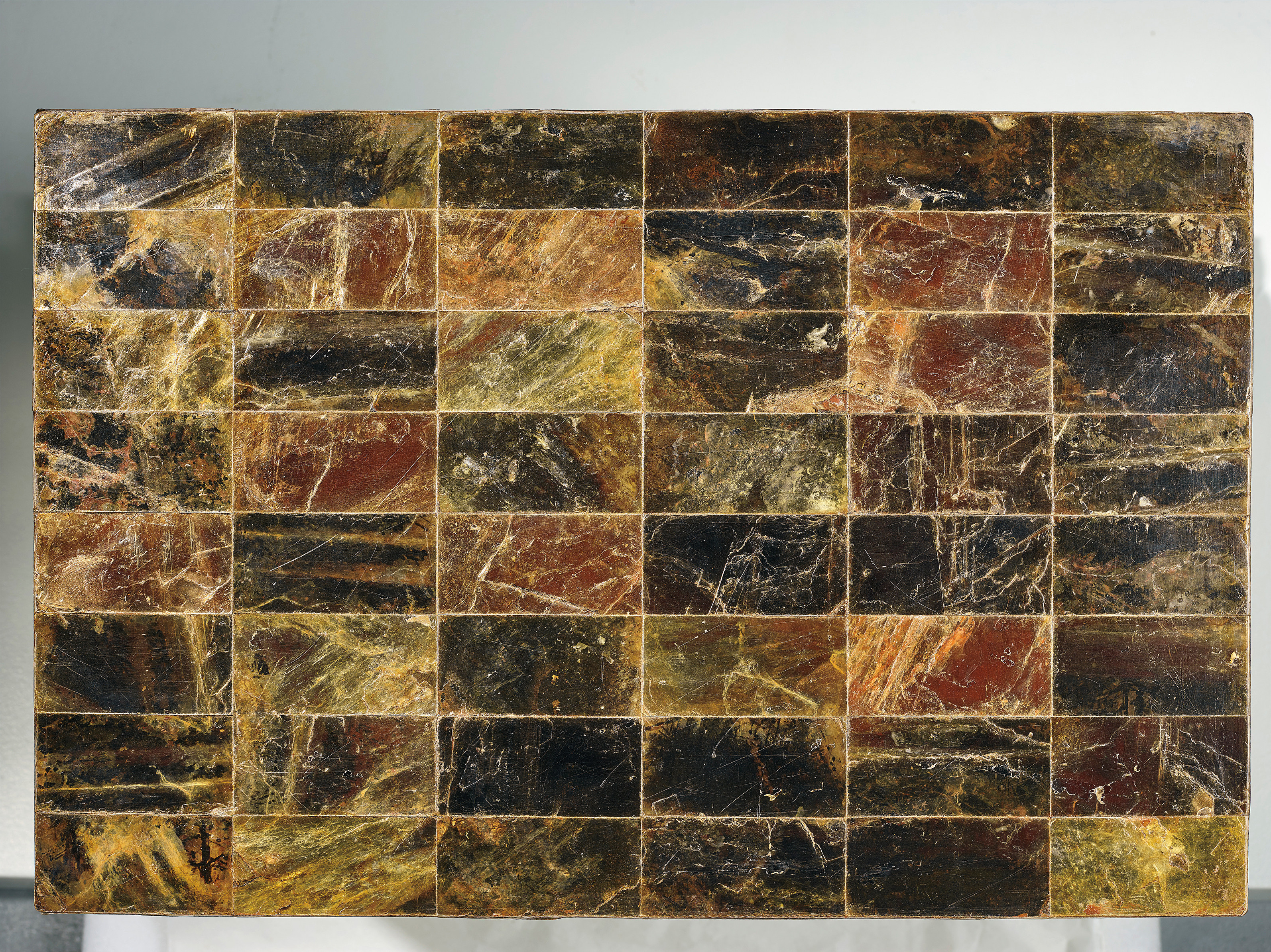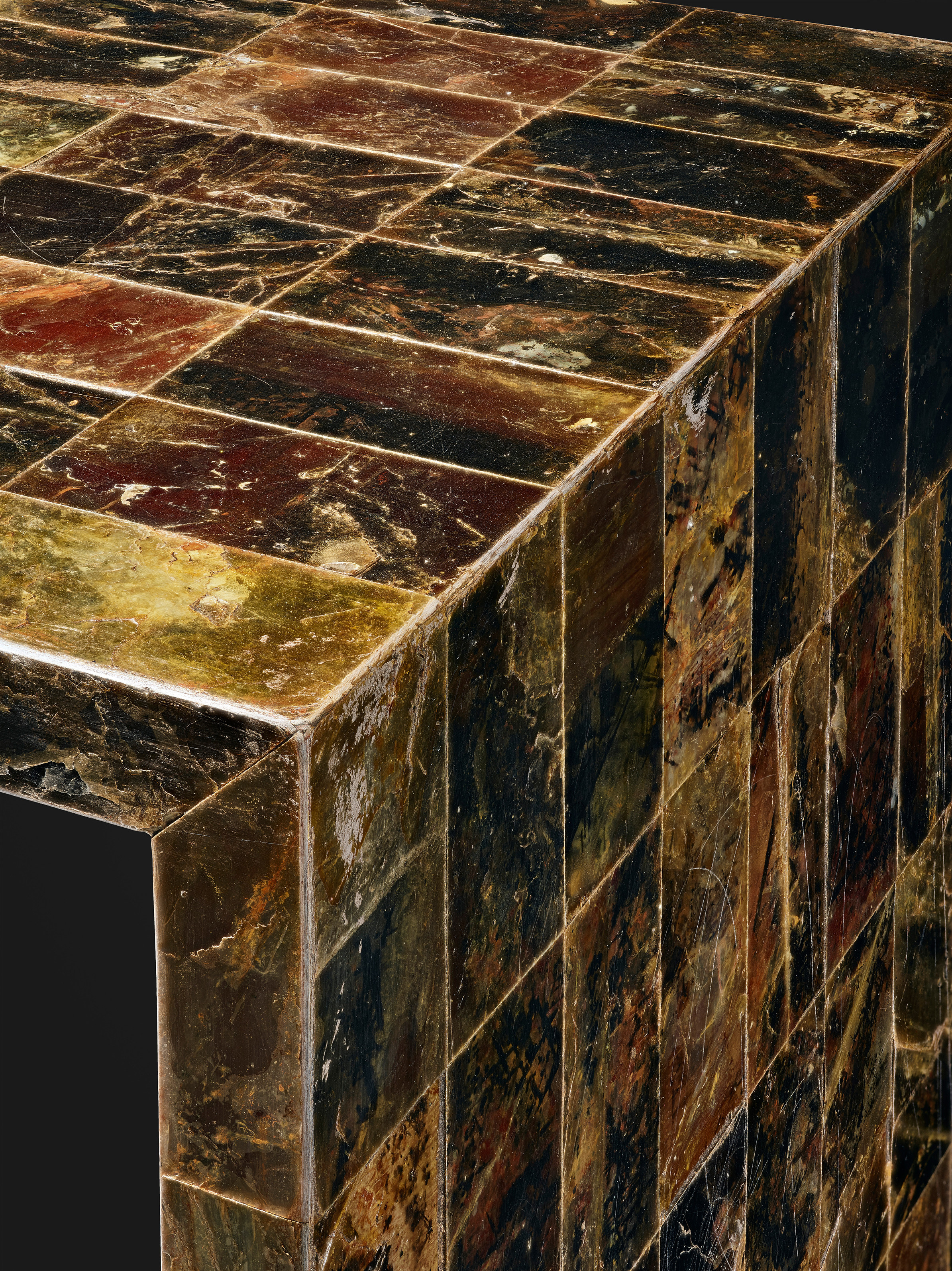





Property of a Private European Collector
214
Jean-Michel Frank
Low table
circa 1928
Mica-covered wood, macassar ebony-veneered wood.
17 3/8 x 23 5/8 x 15 5/8 in. (44.1 x 60 x 39.7 cm)
Produced by Chanaux & Pelletier, Paris, France. Underside of tabletop and each leg impressed with manufacturer's mark CP, underside of one leg further impressed MADE IN FRANCE, J.M.FRANK, and 8674. Together with a certificate of authenticity from the Comité Jean-Michel Frank.
Full-Cataloguing
Jean-Michel Frank: A Fascination for Materials
A fascination for materials was central to Jean-Michel Frank’s practice as a designer. His contemporaries in the Union des Artistes Modernes (UAM) shared his love of materials, but for Frank, who never formally belonged to any modernist movement, materials were a means, not an end (Vivier, 2012, p. 302). Though his furniture was rooted in the tradition of fine cabinetry, he never devoted himself to a particular craft in the sense that Eileen Gray was a student of lacquer or Pierre Chareau favored wrought iron. He selected materials and their various textures—from straw to mica, plaster, terracotta, shagreen, obsidian, and parchment—like paints in a palette that contributed to the greater decorative scheme. In keeping with his modernist contemporaries, however, Frank did not subscribe to a hierarchy of materials. To this end, he was among the first designers to clad furniture in shagreen and parchment, but he also applied traditional materials in novel ways, for example covering walls in straw marquetry and upholstering with canvas.
The following seven lots, culled from several private European collections, are a celebration of Jean-Michel Frank’s inventive use of materials, from the mica-covered table to the obsidian lamp; the white plaster ceiling light; the terracotta-topped guéridon; and the terracotta candle holders, gilt “Trépied à feuille” table lamp, and tall patinated bronze "Figure Version Étroite" floor lamp created by Alberto Giacometti for Frank. Each of these austere objects exhibits perfection of form, stripped of everything but the essential and independent of historical references and styles. The dignity and beauty of the materials hold forth, unencumbered by excess ornament.
Frank’s radical yet sophisticated style earned him the patronage of compelling figures, from the Parisian couturier Elsa Schiaparelli to American millionaires Templeton Crocker and Nelson A. Rockefeller. Yet he was much more than just a society decorator. He operated at the very center of interwar Paris’s artistic and intellectual life. Clients included composers and writers; Man Ray documented his interiors. In particular, Frank’s collaboration with contemporary painters and sculptors set him apart from other designers during this period and captured the attention of the press. La Flèche de Paris compared him to Louis XIV’s chief architect: “Like Mansart in times past…J.M. Frank has gathered around him as craftsmen the best of today’s young artists.”
Mica
The physical properties of mica have been revered by artisans since ancient times. A mineral composed of aluminum silicate, it is heat resistant and naturally cleaves into perfect sheets, which makes it an ideal material for glazing windows, as the ancient Romans did. Japanese artisans admired its metallic luster, inlaying it in lacquer and applying the luminous powder to block prints. It’s clear that Jean-Michel Frank revered mica as much as his ancient predecessors did and reserved its use for some of his most important commissions, such as the sitting room of Charles and Marie-Laure de Noailles, where he clad the fireplace surround in mica (1926). The same treatment appeared again in Templeton Crocker’s San Francisco penthouse (1929). Similar mica-covered tables appeared in the designer’s own smoking room (1938).
A fascination for materials was central to Jean-Michel Frank’s practice as a designer. His contemporaries in the Union des Artistes Modernes (UAM) shared his love of materials, but for Frank, who never formally belonged to any modernist movement, materials were a means, not an end (Vivier, 2012, p. 302). Though his furniture was rooted in the tradition of fine cabinetry, he never devoted himself to a particular craft in the sense that Eileen Gray was a student of lacquer or Pierre Chareau favored wrought iron. He selected materials and their various textures—from straw to mica, plaster, terracotta, shagreen, obsidian, and parchment—like paints in a palette that contributed to the greater decorative scheme. In keeping with his modernist contemporaries, however, Frank did not subscribe to a hierarchy of materials. To this end, he was among the first designers to clad furniture in shagreen and parchment, but he also applied traditional materials in novel ways, for example covering walls in straw marquetry and upholstering with canvas.
The following seven lots, culled from several private European collections, are a celebration of Jean-Michel Frank’s inventive use of materials, from the mica-covered table to the obsidian lamp; the white plaster ceiling light; the terracotta-topped guéridon; and the terracotta candle holders, gilt “Trépied à feuille” table lamp, and tall patinated bronze "Figure Version Étroite" floor lamp created by Alberto Giacometti for Frank. Each of these austere objects exhibits perfection of form, stripped of everything but the essential and independent of historical references and styles. The dignity and beauty of the materials hold forth, unencumbered by excess ornament.
Frank’s radical yet sophisticated style earned him the patronage of compelling figures, from the Parisian couturier Elsa Schiaparelli to American millionaires Templeton Crocker and Nelson A. Rockefeller. Yet he was much more than just a society decorator. He operated at the very center of interwar Paris’s artistic and intellectual life. Clients included composers and writers; Man Ray documented his interiors. In particular, Frank’s collaboration with contemporary painters and sculptors set him apart from other designers during this period and captured the attention of the press. La Flèche de Paris compared him to Louis XIV’s chief architect: “Like Mansart in times past…J.M. Frank has gathered around him as craftsmen the best of today’s young artists.”
Mica
The physical properties of mica have been revered by artisans since ancient times. A mineral composed of aluminum silicate, it is heat resistant and naturally cleaves into perfect sheets, which makes it an ideal material for glazing windows, as the ancient Romans did. Japanese artisans admired its metallic luster, inlaying it in lacquer and applying the luminous powder to block prints. It’s clear that Jean-Michel Frank revered mica as much as his ancient predecessors did and reserved its use for some of his most important commissions, such as the sitting room of Charles and Marie-Laure de Noailles, where he clad the fireplace surround in mica (1926). The same treatment appeared again in Templeton Crocker’s San Francisco penthouse (1929). Similar mica-covered tables appeared in the designer’s own smoking room (1938).
Jean-Michel Frank
French | B. 1895 D. 1941Working in Paris, New York and Argentina, Jean-Michel Frank designed subtle, exquisitely proportioned furniture and lighting for sophisticated interiors. His elite roster of patrons included the vicomte Charles de Noailles, the businessman and politician Nelson A. Rockefeller, the couturier Elsa Schiaparelli and the perfumer Guerlain, among many others. Against the backdrop of the interwar period, Frank designed calm, subdued interiors that offered refuge from the chaotic world. His furniture, which was often clad in vellum, bleached leather or shagreen, featured clean lines and served to complement the art collections of his clients, which included works by Picasso, Léger and Matisse.